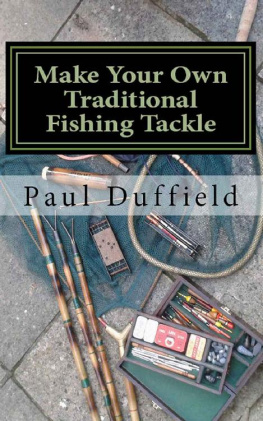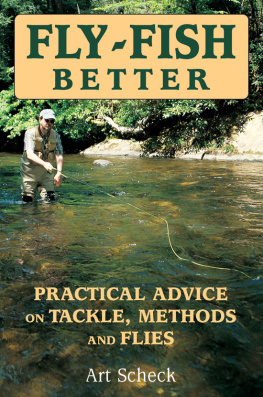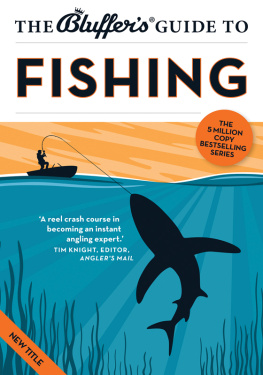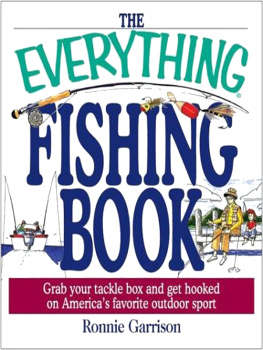Paul Duffield - Make Your Own Traditional Fishing Tackle
Here you can read online Paul Duffield - Make Your Own Traditional Fishing Tackle full text of the book (entire story) in english for free. Download pdf and epub, get meaning, cover and reviews about this ebook. year: 2012, publisher: Make Your Own Traditional Fishing Tackle, genre: Home and family. Description of the work, (preface) as well as reviews are available. Best literature library LitArk.com created for fans of good reading and offers a wide selection of genres:
Romance novel
Science fiction
Adventure
Detective
Science
History
Home and family
Prose
Art
Politics
Computer
Non-fiction
Religion
Business
Children
Humor
Choose a favorite category and find really read worthwhile books. Enjoy immersion in the world of imagination, feel the emotions of the characters or learn something new for yourself, make an fascinating discovery.
- Book:Make Your Own Traditional Fishing Tackle
- Author:
- Publisher:Make Your Own Traditional Fishing Tackle
- Genre:
- Year:2012
- Rating:4 / 5
- Favourites:Add to favourites
- Your mark:
- 80
- 1
- 2
- 3
- 4
- 5
Make Your Own Traditional Fishing Tackle: summary, description and annotation
We offer to read an annotation, description, summary or preface (depends on what the author of the book "Make Your Own Traditional Fishing Tackle" wrote himself). If you haven't found the necessary information about the book — write in the comments, we will try to find it.
Make Your Own Traditional Fishing Tackle — read online for free the complete book (whole text) full work
Below is the text of the book, divided by pages. System saving the place of the last page read, allows you to conveniently read the book "Make Your Own Traditional Fishing Tackle" online for free, without having to search again every time where you left off. Put a bookmark, and you can go to the page where you finished reading at any time.
Font size:
Interval:
Bookmark:
Make Your Own Traditional Fishing Tackle
PAUL DUFFIELD
Copyright 2012 Paul Duffield
All rights reserved.
CONTENTS
In recent years there has been a revival in traditional angling. The definition of traditional angling is a matter for personal choice, but one thing that many anglers who consider themselves to be traditional have in common is a preference for fishing with tackle that is hand made using natural materials.
While modern fishing tackle is perfectly usable and efficient for its intended purpose, to many, modern plastics and other man made materials are less pleasing to the eye and seem out of place in a natural environment such as a river or tree lined lake.
While there is no shortage of split cane fishing rods, centrepin reels and traditional fishing floats to buy, both vintage and new, it is less easy to find traditional accessories such as wood and cane landing nets, cane net handles, bank sticks and rod rests. There are a few skilled craftsmen still making these items to a high standard, but waiting lists can be long and prices can be high.
When I first became interested in vintage and traditional fishing tackle I searched for books on tackle making so I could make my own. I found some books on float making and some very old books on rod building, but few on making general tackle items.
Those books I did find were mainly about making artificial baits such as spinners and flies or items that are not used today, such as gaffs and minnow traps, so the items described in this book came about from the application of common sense, trial and error, and helpful tips and suggestions from like minded anglers.
The purpose of this book is to provide the reader with the information needed to produce a range of traditional fishing tackle items that not only work, but look good too. There can be a lot of satisfaction in using traditional fishing tackle and methods, and if you are using tackle that you have made yourself, the satisfaction can be that much more.
While I would not want to pretend that these items can be made by anyone to the high standard that the few remaining craftsmen accomplish, making these items to a good standard is well within the capabilities and budget of most if not all anglers using inexpensive readily available materials and basic tools.
For anglers who would like to use traditional fishing tackle but are on a restricted budget, the techniques described in this book can help to save many pounds over the cost of buying ready made items. If you only make a couple of cane rod rests or a handful of quill floats, the money you save will more than cover the cost of this book.

In this chapter I will cover some basic tools and techniques that you will use when making many of the items in this book.
First we will consider tools and basic materials. If you have ever done any home DIY, you will have many of these items already. There is no need for a wide array of specialist tools, but you will find some tasks easier with a tool or gadget made for the purpose. Heres what you will need:
A saw suitable for cutting wood and cane such as a Tenon Saw.
A saw suitable for cutting metal such as a Junior Hacksaw.
A pipe cutter
3/8inch BSF tap
A selection of coarse, medium and fine grade abrasive paper suitable for sanding wood and metal.
A selection of medium and fine wire wool.
A selection of small craft or artists paint brushes
Sharp knife such as disposable craft knives or a Stanley knife
Razor blades
Some rod whipping thread.
Colour preserver or sealer for whippings
Waterproof varnish
White spirit or brush cleaner
Masking Tape
Strong two part epoxy glue
In the remainder of this chapter I will cover some basic techniques that will be referred to in later chapters.
Preparing New Cane
Ordinary garden cane available from garden centres can be used to make traditional rod rests and landing net handles, but it needs preparation to remove moisture, flatten nodes and make it straight.
Some cane is quite suitable with little or no drying if it has already been dried before being exported, and this cane can be recognised by its straw colour . Avoid cane that looks green or that has been left outside exposed to the elements and shows signs of rotting or water damage at the end.
Cane can be heated over a gas flame to remove any remaining moisture, but be careful not to leave the cane in the flame too long or it will scorch or burn. It is best to move the cane in and out of the flame while at the same time rotating it, to avoid overheating.
As the enamel on the outside of the cane is waterproof, the moisture will be driven to the end of the cane when heated and will steam or drip out of the end.
Preparing Reclaimed Cane
Cane reclaimed from old fishing rods is ideal for making traditional fishing tackle items such as banksticks and landing net handles.
To prepare reclaimed cane for use you need to remove old varnish and any rings and whippings that remain. Rings and whippings can be removed by either slicing through all of the whippings with a sharp knife, so the whole whipping can be peeled off in a singe piece, or cutting through the whipping at one end and unwinding it from the rod.
To remove old varnish, you can use a varnish stripper and this is a technique used by many rod restorers, but alternatively the varnish can be easily removed by carefully scraping it off with a craft knife, and finishing with fine sandpaper. If you use this technique, be careful that you do not press too hard with the knife and cut into the cane.
Straightening Cane
Cane sections are rarely straight and will need to be heated to remove bends and kinks. The techniques used for straightening whole cane sections can also be used to remove bends, known as sets in split cane fishing rods.
To straighten cane is it necessary to heat it make it pliable and then bend the cane straight until it cools. I use a domestic gas ring to heat the cane, but other restorers use a variety of heating methods including candles, methylated spirit burners and even heat guns.
Whichever method you use, you must be careful not to overheat the cane. At best you will scorch it, at worst you may set fire to it!
The method I use is to hold the cane either side of the bend wearing a pair of thick gardening gloves and rotate the cane just above the gas flame while simultaneously moving it in a figure of eight movement so no part of the cane is above the flame for long.
When the cane is just too hot to hold comfortably without gloves, it is hot enough, and you can bend the cane a little more than necessary to straighten it so it just bends a little the other way. Hold it in this position until it has cooled and release the tension. You may need to do this more than once if the bend is persistent.
If there are several bends, start at one end of the cane and repeat the process for each bend working along the cane rather than trying to remove all bends in one go.
As soon as I am happy that the cane is as straight as I can get it, I rub a damp cloth over the heated area to cool it down.
Flattening Nodes
If the length of cane you are using has any nodes protruding from the cane these may be removed either by carefully cutting them with a craft knife or rubbing them flat with a wood file and finishing off with sandpaper.

Font size:
Interval:
Bookmark:
Similar books «Make Your Own Traditional Fishing Tackle»
Look at similar books to Make Your Own Traditional Fishing Tackle. We have selected literature similar in name and meaning in the hope of providing readers with more options to find new, interesting, not yet read works.
Discussion, reviews of the book Make Your Own Traditional Fishing Tackle and just readers' own opinions. Leave your comments, write what you think about the work, its meaning or the main characters. Specify what exactly you liked and what you didn't like, and why you think so.






